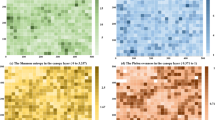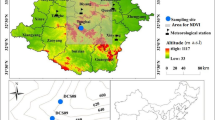Abstract
Tree height (H) of Kandelia obovata trees decreased sharply from 5 m at the forest interior behind the terrestrial forest to 1.5 m at the forest edge near the river bank according to an increase in the yearly waterlogged period along a belt transect. The decreasing tree stature was attributed to a decrease in the asymptote of H in the D 0.1 (stem diameter at H/10)-H relationship toward the edge. The K. obovata trees were well classified into interior and edge types using a discriminant function based on the habitat-specific D 0.1–H relationships. Allometric equations, as a function of D 20.1 H, differed significantly between the interior and edge types in the estimation of the phytomasses of stems and leaves, and the leaf area per tree. On the other hand, common allometric equations were successfully established in the estimation of respective phytomasses of aboveground parts and branches. Biomass and leaf area index decreased toward the forest edge. The biomass allocation to stems decreased toward the edge, whereas those to branches and leaves increased. A dramatic change in stem diameter increment resulted in differences in the D 0.1–H relationship along the tree height gradient. Relative growth rate of biomass and light-saturated net photosynthesis, which paralleled net assimilation rate from the interior to the edge, showed their maximum peaks in the middle of the belt transect. This indicates that there exists an optimal environmental condition for growth of K. obovata trees. Leaf nitrogen content tended to increase to the edge with increasing waterlogged period.











Similar content being viewed by others
References
Anten NPR, Schieving F, Werger MJA (1995) Patterns of light and nitrogen distribution in relation to whole canopy gain in C3 and C4 mono- and dicotyledonous species. Oecologia 101:504–513
Ball MC, Cowan IR, Farquhar GD (1988) Maintenance of leaf temperature and the optimisation of carbon gain in relation to water loss in a tropical mangrove forest. Aust J Plant Physiol 15:263–276
Björkman O (1981) Responses to different quantum flux densities. In: Lange OL, Nobel PS, Osmond CB, Ziegler H (eds) Physiological plant ecology I. Responses to the physical environment. Springer-Verlag, Berlin, pp 57–107
Bradley PM, Morris JT (1990) Influence of oxygen and sulfide concentration on nitrogen uptake kinetics in Spartina alterniflora. Ecology 71:282–287
Cardona P, Botero L (1998) Soil characteristics and vegetation structure in a heavily deteriorated mangrove forest in the Caribbean Coast of Colombia. Biotropica 30:24–34
Chen L, Wang W, Lin P (2005) Photosynthetic and physiological responses of Kandelia candel L. Druce seedlings to duration of tidal immersion in artificial seawater. Environ Exp Bot 54:256–266
Cintrón G, Lugo AE, Pool DJ, Morris G (1978) Mangroves of arid environments in Puerto Rico and adjacent islands. Biotropica 10:110–121
Clough BF, Dixon P, Dalhaus O (1997) Allometric relationships for estimating biomass in multi-stemmed mangrove trees. Aust J Bot 45:1023–1031
Coronado-Molina C, Day JW, Reyes E, Perez BC (2004) Standing crop and aboveground biomass partitioning of a dwarf mangrove forest in Taylor River Slough, Florida. Wetlands Ecol Manage 12:157–164
DeJong TM, Doyle JF (1985) Seasonal relationships between leaf nitrogen content (photosynthetic capacity) and leaf canopy light exposure in peach (Prunus persica). Plant Cell Environ 8:701–706
Duke NC, Ball MC, Ellison JC (1998) Factors influencing biodiversity and distributional gradients in mangroves. Glob Ecol Biogeogr Lett 7:27–47
Ellison AM, Farnsworth EJ (1997) Simulated sea level change alters anatomy, physiology, growth, and reproduction of red mangrove (Rhizophora mangle L). Oecologia 112:435–446
Feller IC (1995) Effects of nutrient enrichment on growth and herbivory of dwarf red mangrove (Rhizophora mangle). Ecol Monogr 65:477–505
Feller IC, McKee KM, Whigham DF, O’Neill JP (2002) Nitrogen vs. phosphorus limitation across an ecotonal gradient in a mangrove forest. Biogeochemistry 62:145–175
Feller IC, Whigham DF, McKee KL, Lovelock CE (2003) Nitrogen limitation of growth and nutrient dynamics in a disturbed mangrove forest, Indian River Lagoon, Florida. Oecologia 134:405–414
Field C, Merino J, Mooney HA (1983) Compromises between water-use efficiency and nitrogen-use efficiency in five species of Californian evergreens. Oecologia 60:384–389
Hagihara A, Yokota T, Ogawa K (1993) Allometric relations in hinoki (Chamaecyparis obtusa (Sieb. et Zucc.) Endl.) trees. Bull Nagoya Univ For 12:11–29
Hall MA, Kapuya JA, Sivakumaran S, John A (1977) The role of ethylene in the respons of plants to stress. Pestic Sci 8:217–223
Hikosaka K (2004) Interspecific difference in the photosynthesis–nitrogen relationship: patterns, physiological causes, and ecological importance. J Plant Res 117:481–494
Hirose T, Werger MJA (1987) Nitrogen use efficiency in instantaneous and daily photosynthesis of leaves in the canopy of a Solidago altissima stand. Physiol Plant 70:215–222
Hogarth PJ (1999) The biology of mangroves. Oxford University Press, New York
Hosokawa T, Tagawa H, Chapman VJ (1977) Mangals of Micronesia, Taiwan, Japan, the Philippines and Oceania. In: Chapman VJ (ed) Wet coastal ecosystems. Elsevier, Amsterdam, pp 271–291
Khan MNI, Suwa R, Hagihara A (2005) Allometric relationships for estimating the aboveground phytomass and leaf area of mangrove Kandelia candel (L.) Druce trees in the Manko Wetland, Okinawa Island, Japan. Trees 19:266–272
Koch MS, Mendelssohn IA, McKee KL (1990) Mechanism for hydrogen sulfide-induced growth limitation in wetland macrophytes. Limnol Oceanogr 35:399–408
Komiyama A, Poungparn S, Kato S (2005) Common allometric equations for estimating the tree weight of mangroves. J Trop Ecol 21:471–477
Lin G, Sternberg LSL (1992) Effect of growth form, salinity, nutrient and sulfide on photosynthesis, carbon isotope discrimination and growth of red mangrove (Rhizophora mangle L.). Aust J Plant Physiol 19:509–517
Lin P (1999) Mangrove ecosystems in China. Science Press, Beijing
Lovelock CE, Feller IC, McKee KL, Thompson R (2005) Variation in mangrove forest structure and sediment characteristics in Bocas del Toro, Panama. Caribb J Sci 41:456–464
Lovelock CE, Feller IC, McKee KL, Engelbrecht BMJ, Ball MC (2004) The effect of nutrient enrichment on growth, photosynthesis and hydraulic conductance of dwarf mangroves in Panamá. Funct Ecol 18:25–33
Lovelock CE, Ball MC, Choat B, Engelbrecht BMJ, Holbrook NM, Feller IC (2006) Linking physiological processes with mangrove forest structure: phosphorus deficiency limits canopy development, hydraulic conductance and photosynthetic carbon gain in dwarf Rhizophora mangle. Plant Cell Environ 29:793–802
Lugo AE, Snedaker SC (1974) The ecology of mangroves. Annu Rev Ecol Syst 5:39–64
McKee KL (1995) Seedling recruitment patterns in a Belizean mangrove forest: effects of establishment ability and physico-chemical factors. Oecologia 101:448–460
Mendelssohn IA, McKee KL (1983) Root metabolic response of Spartina alterniflora to hypoxia. In: Crawford RMM (ed) Plant life in aquatic and amphibious habitats. Brit Ecol Soc Special Publication No. 5, pp 239–253
Mendelssohn IA, McKee KL, Patrick WH Jr (1981) Oxygen deficiency in Spartina alterniflora roots: metabolic adaptation to anoxia. Science 214:439–441
Mitsch WJ, Ewel KC (1979) Comparative biomass and growth of cypress in Florida wetlands. Am Midl Nat 101:417–426
Naidoo G (2006) Factors contributing to dwarfing in the mangrove Avicennia marina. Ann Bot 97:1095–1101
Nakasuga T (2002) Stand structure of mangrove forest in Manko estuary, Naha, Okinawa (in Japanese with English summary). In: A comprehensive study on mangroves in Okinawa islands, 2002. Research Institute for Subtropics, Okinawa, pp 211–220
Ogawa H, Kira T (1977) Methods of estimating forest biomass. In: Shidei T, Kira T (eds) Primary productivity of Japanese forests. University Tokyo Press, Tokyo, pp 15–25/35–36
Ong JE, Gong WK, Wong CH (2004) Allometry and partitioning of the mangrove, Rhizophora apiculata. For Ecol Manage 188:395–408
Pezeshki SR, Anderson PH (1997) Responses of three bottomland species with different flood tolerance capabilities to various flooding regimes. Wetlands Ecol Manage 4:245–256
Piou C, Feller IC, Berger U, Chi F (2006) Zonation patterns of Belizean offshore mangrove forests 41 years after a catastrophic hurricane. Biotropica 38:365–374
Poungparn S, Komiyama A, Patanaponpaipoon P, Jintana V, Sangtiean T, Tanapermpool P, Piriyayota S, Maknual C, Kato S (2002) Site-independent allometric relationships for estimating above-ground weights of mangroves. Tropics 12:147–158
Ross MS, Ruiz PL, Telesnicki GJ, Meeder JF (2001) Estimating above-ground biomass and production in mangrove communities of Biscayne National Park, Florida (U.S.A.). Wetlands Ecol Manage 9:27–37
Schieving F, Pons TL, Werger MJA, Hirose T (1992) The vertical distribution of nitrogen and photosynthetic activity at different plant densities in Carex acutiformis. Plant Soil 14:9–17
Sherman RE, Fahey TJ, Martinez P (2003) Spatial patterns of biomass and aboveground net primary productivity in a mangrove ecosystem in the Dominican Republic. Ecosystems 6:384–398
Sheue C-R, Liu H-Y, Yong JWH (2003) Kandelia obovata (Rhizophoraceae), a new mangrove species from Eastern Asia. Taxon 52:287–294
Smith TJ III (1992) Forest structure. In: Robertson AI, Alongi DM (eds) Tropical mangrove ecosystems. American Geological Union, Washington, DC, pp 101–136
Smith TJ III, Whelan KRT (2006) Development of allometric relations for three mangrove species in South Florida for use in the greater Everglades ecosystem restoration. Wetlands Ecol Manage 14:409–419
Suwa R, Khan MNI, Hagihara A (2006) Canopy photosynthesis, canopy respiration and surplus production in a subtropical mangrove Kandelia candel forest, Okinawa Island, Japan. Mar Ecol Prog Ser 320:131–139
Wample RL, Reid DM (1979) The role of endogenous auxin and ethylene in the formation of adventitious roots and hypocotyl hypertrophy in flooded sunflower plants (Helianthus annuus). Physiol Plant 45:219–226
Yamamoto F (1992) Effects of depth of flooding on growth and anatomy of stems and knee roots of Taxodium distichum. IAWA Bull 13:93–104
Yamamoto F, Kozlowski TT (1987a) Effects of flooding, tilting of stems, and Ethrel application on growth, stem anatomy and ethylene production of Pinus densiflora seedlings. J Exp Bot 38:293–310
Yamamoto F, Kozlowski TT (1987b) Regulation by auxin and ethylene of responses of Acer negundo seedlings to flooding of soil. Environ Exp Bot 27:329–340
Ye Y, Tam NFY, Wong YS, Lu CY (2003) Growth and physiological responses of two mangrove species (Bruguiera gymnorrhiza and Kandelia candel) to waterlogging. Environ Exp Bot 49:209–221
Youssef T, Saenger P (1998) Photosynthetic gas exchange and accumulation of phytotoxins in mangrove seedlings in response to soil physico-chemical characteristics associated with waterlogging. Tree Physiol 18:317–324
Acknowledgments
We thank Dr. S. M. Feroz and Mr. H. A. T. M. Rafiqul for providing helpful suggestions. This study was partially supported by Grants-in-Aid for Scientific Research (nos. 16201009 and 16651009) from the Ministry of Education, Culture, Sports, Science, and Technology, Japan, and the 21st Century COE program of the University of the Ryukyus.
Author information
Authors and Affiliations
Corresponding author
Rights and permissions
About this article
Cite this article
Suwa, R., Analuddin, K., Khan, M.N.I. et al. Structure and productivity along a tree height gradient in a Kandelia obovata mangrove forest in the Manko Wetland, Okinawa Island, Japan. Wetlands Ecol Manage 16, 331–343 (2008). https://doi.org/10.1007/s11273-007-9071-5
Received:
Accepted:
Published:
Issue Date:
DOI: https://doi.org/10.1007/s11273-007-9071-5




